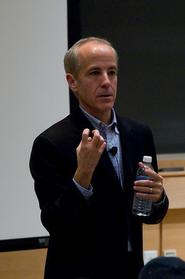
Jim Kennedy, vice president and director for strategic planning at the Associated Press, presented "The New Model for News" on February 3 in the Science Center. The presentation focused on how the Associated Press (AP) is confronted with the challenge of restructuring the news to fit the new generational consumption of media. Kennedy provided detailed information regarding how the AP addressed this problem as well as solutions for news consumption in the future.
Kennedy began by asserting his presentation was an "inconvenient truth about media." After giving listeners a brief history of the Associated Press and its connection to the telegraph, he coined the telegraph as the first "disruption that affected the news." He then went on to outline the main disruptions of news in today's media, listing digital disruptions such as broadband connectivity which drove media consumption to the internet, Google, which became a hot spot for bits of news drawn for news websites, devices such as cell phones that make people in charge of their own consumption, and finally the generational shift that makes these disruptions permanent.
In order to address this "generational shift," the AP hired a team of anthropologists to study a small group of people in six cities around the globe, tracking each person's daily consumption of media. According to Kennedy, the purpose was to "target their behaviors, what products and services they used, and why." During their experiment, the AP found that news is essentially connected to e-mail, multi-tasked, and that consumers are experiencing "news fatigue," which refers to a constant bombardment of information that takes the suspense out of news.
The study also found that consumers want full-coverage of news events at their fingertips as they happen--a standard not yet achieved by the old model for news. As a result, the AP formulated a new model for news that will break the barriers that challenged old model media.
Whereas the old model spoon-fed consumers news stories layer by layer, Kennedy explain that the new model for news makes "us the editors." We piece together the report as opposed to news companies, an approach that solves the puzzle of how to connect users to pieces of a story relatively quickly through various media outlets. The main challenge, as Kennedy stated, rests in the ability to get the "right content to the right people at the right time" in a way that generates profit but still "atomizes news" to make it widely accessible.
Kennedy maintains that this new approach to media by the AP will soon be obvious in various media outlets and has already set a new precedent in connection with the I-phone. He ended the presentation by asserting that the new generation is extremely lucky in its future abilities to continue shaping this new model of news for generations to come, admitting that while it is inevitable that obstacles will arise, new model news is an exciting prospect for the future of journalism.
As business editor of AP, Kennedy led the agency's award-winning coverage of the stock market crash in 1987 and oversaw the development of new data services that first enabled newspapers to customize their listings of stocks and mutual funds. In 1995, he was tapped to lead a new department that created The WIRE, AP's first Web-based news service, honored in 1999 by the Smithsonian Institution.
Kennedy has been a board member and president of the Society of American Business Editors and Writers, a founding member of the Media Center at the American Press Institute, and a founder and board member of the Online News Association.
He began his journalism career at The Ogdensburg (N.Y.) Journal as a reporter and later managing editor. He also spent several years as a bureau chief, foreign correspondent and business editor for The Tampa (Fla.) Tribune before moving to AP.
